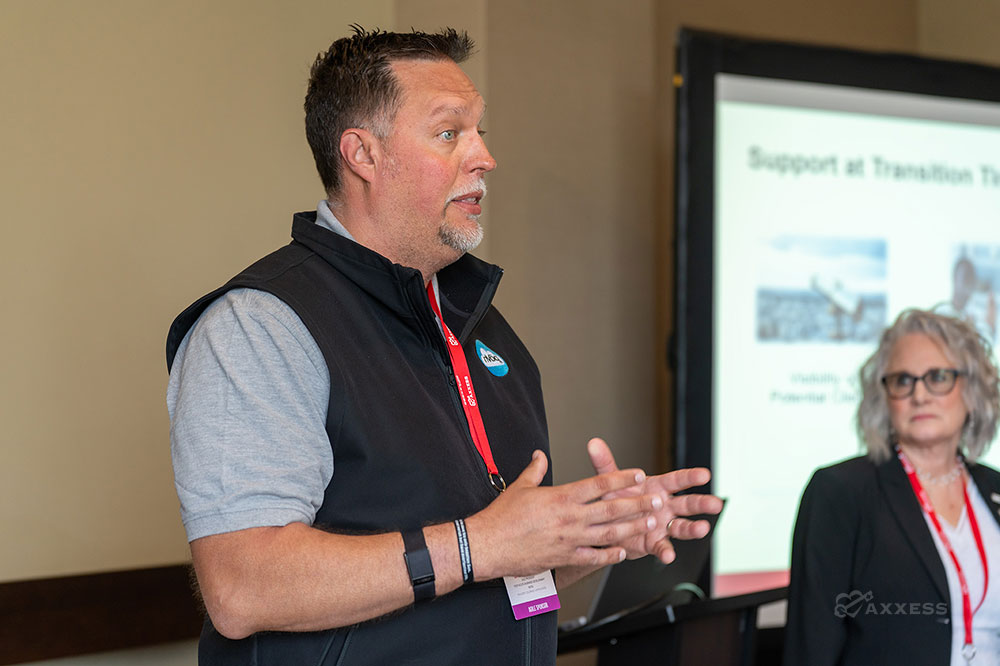
When she was visiting a patient, Raianne Melton, RN, BSN, CHPN, now Senior Clinical Manager of Professional Services for Axxess, asked the patient if he had completed an advance directive. The patient stated he didn’t know, called his daughter and asked her if she had “the paperwork that says you can put me down.”
In an education session at the 2023 Axxess Growth, Innovation and Leadership Experience (AGILE), Melton shared this story to illustrate how patients and families may need extra support and guidance when transitioning between palliative care and hospice care. Melton and Jason Banks, Vice President of Post-Acute Business Development for nVoq, discussed how care at home teams can support these patient transitions.
Planning a Transition From Palliative Care
Palliative and hospice care are both interdisciplinary models of care that focus on goals and symptom management. Palliative care can be provided to anyone experiencing a serious illness who wishes to receive curative care, while hospice is a specific type of palliative care that is provided when a patient has a life expectancy of six months or less and chooses to forgo curative treatment and focus on comfort.
Orchestrating a seamless transition between care settings can greatly improve the experience for patients and families. One way organizations can facilitate this is to encourage collaboration between palliative care and hospice teams in interdisciplinary group meetings. When hospice team members can sit in on palliative care interdisciplinary group (IDG) meetings, they can offer insight on patients that may soon be appropriate for hospice, which prepares the hospice team for onboarding these patients.
“It created this continuity with the hospice teams that said, ‘We’re going to be better prepared when these patients come on because we know about them; we discussed them during our hospice IDG,’” Banks said. “Folks like the RN case manager and social worker were already much more prepared and ready than when we might get a hospice-specific referral that they might have very little valid information on.”
Educating patients and families on advance directives can also aid this transition. Advance directives enable people to document what treatments they wish to receive if they could not speak for themselves, but many don’t know exactly what an advance directive, medical power of attorney or living will entail. Melton described how her team at a previous organization addressed this.
“We created some workshops where we would bring people together in a safe environment to talk about, what does it mean to say you want a medical power of attorney?” Melton said. “We had a lot of fun with these, and we also really improved our medical power of attorney completion and our living will completion.”
Using technology-enabled predictors can help teams see when a patient is moving toward the time for a transition, help keep patients out of the hospital and ensure transitions from palliative care to hospice happen at the right time.
“Using all of your technology to better [predict] when someone is hospice eligible and communicating that at each visit [along] with a trajectory of the disease, then bringing the hospice nurse to visits in order to build relationships really will help,” Melton said.
Preparing Patients for the Transition From Palliative to Hospice
As a patient’s disease progresses, collaboration among the medical teams caring for them can ease the transition. This includes using similar language that is clear and precise.
“Being collaborative about the messaging to a patient and family is just so important,” Banks said. “Part of this is communicating with the patient and family, and part of it is communicating internally, using plain English.”
Some organizations also use bridge programs, which can ease patients from palliative care to end-of-life care. Understanding and accepting that a patient may need a different level of care can be a difficult transition. When care teams can meet these patients where they are and when they need that extra support, they can easily connect them to the most appropriate level of care.
“We found a sweet spot in going to visit patients about two weeks after they had been admitted to a skilled nursing facility after an acute care stay,” Banks said. “After two weeks of intensive therapy, the futility of their circumstance came into focus for them and their family, and they realized they [needed] something more to help.”
Ultimately, communication among providers and with the patient and family is the core tenant that eases transitions, helps patients understand their illness and helps the patient and their family get the right care at the right time.
“I had [a registered nurse and licensed practical nurse], and their sole job was to be in contact with patients that had been identified in our group and to build a relationship with them, keep in contact with them, to talk about the right service at the right time,” Melton said. “It became a trusted source of truth for that patient and family.”
Receiving the right care at the right time supports both the patient and family. Embracing these recommendations enhances the patient’s and family’s experience and reduces stress as they transition between services.
With more than 250 attendees, more than 40 sponsors and countless connections made, AGILE 2023 was a massive success for everyone. Check out the recap video and mark your calendar for AGILE 2024, April 21-24 in Dallas.
